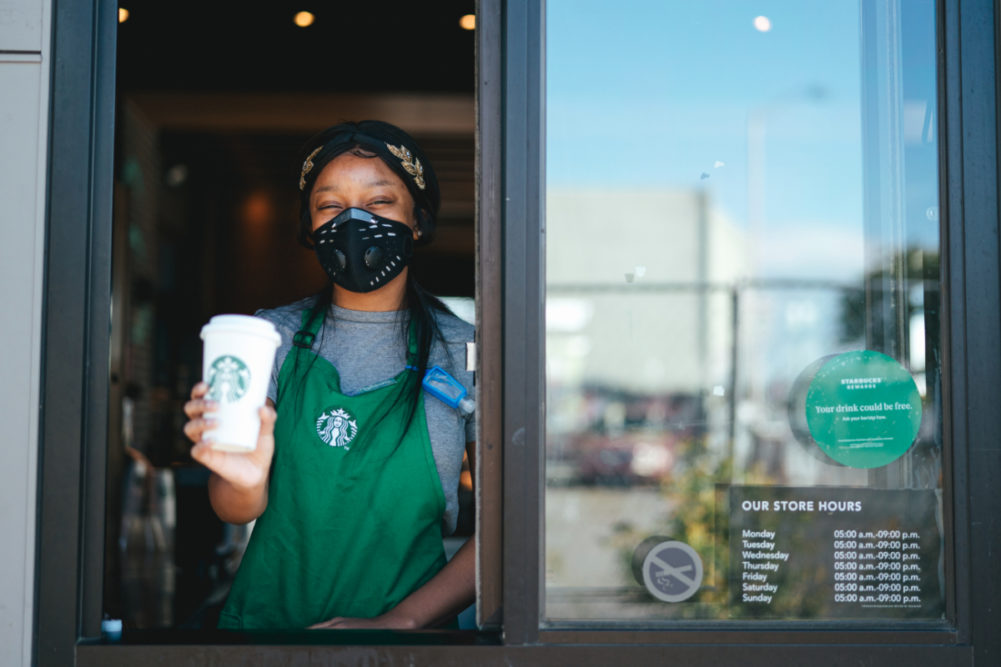The message Starbucks Corp. executives delivered to the investment community during its April 28 conference call to discuss second-quarter results was simple — It’s going to get worse before it gets better. In the United States, which is part of the company’s largest business unit, executives said the negative financial impact of the coronavirus (COVID-19) will be significantly greater in the third quarter compared to the second quarter and extend into the fourth quarter.
“At the enterprise level, we expect the absolute flow-through impact of COVID-19 to be materially greater in Q3 compared to Q2, in particular due to the longer duration of US, Canada and Japan business disruption in Q3 compared to Q2,” said Patrick J. Grismer, chief financial officer.
Net income for the second quarter ended March 29 fell 51% to $328.4 million, equal to 28¢ per share on the common stock, down sharply from $663.2 million, or 53c per share, in the same period a year ago. Quarterly revenues fell 4.9% to $5.6 billion from $6.31 billion a year ago.
Management declined to offer formal guidance for the rest of fiscal 2020, stating there are too many unknowns.
“Continued recovery in China strengthens our belief that these impacts are temporary and that we will emerge from this global pandemic with new insights and capabilities that will make our business even stronger and more relevant,” said Kevin R. Johnson, chief executive officer.
Johnson used Starbucks’ China experience as a potential roadmap for how other developed markets may recover. During the second quarter, year-over-year sales in China declined by $325 million, almost 50% when compared with the same period of the previous year. Yet there has been improvement, he said, with April sales down 35% when compared with April 2019, and an improvement from February 2020, when sales were down as much as 90%.
“Today, almost 100% of our stores in China are open, many with limited seating, reduced hours and other safety protocols in place,” he said. “Starbucks stores that remain closed in China are primarily located in cinemas and enclosed entertainment venues, along with international travel hubs and certain tourist zones, where restrictions are still in effect.
“We believe, barring any new disruptions, that our business in China is on a path to substantial recovery by the end of this fiscal year.”
In Starbucks’ Americas business unit, its largest, quarterly revenues were $4.33 billion, flat when compared with fiscal 2019 sales of $4.31 billion. Operating income fell 27% to $621 million.
“Prior to mid-March, revenue growth in the US was accelerating to the strongest level in over four years, driven by comparable store sales growth of 8%, including comparable transaction growth of 4%,” Johnson said. “Additionally, two-year comps were tracking to 12% growth, the strongest in over three years.
“In that final three weeks of Q2, US comp sales swiftly decelerated, ending the quarter down 3%, driven by a 7% contraction in traffic comp.”
As of April 28, approximately 50% of Starbucks’ company-operated stores and 46% of its licensed stores in the United States are closed. A significant difference between Starbucks’ recovery in China and the United States is how each market is opening. In China, the opening has been managed by the central government.
“The opening of stores (in China) was over a longer period of time than I think we're going to see in the US, but it was orchestrated city-by-city and almost community-by-community centrally,” Johnson said.
In the United States, the recovery will be managed by states and local governments.
“We are now leveraging digital tools that enable us to monitor the COVID-19 situation in every community across the US and leverage a variety of service options, from contactless service, entryway pickup, curbside delivery where parking is available and at home delivery, that allow us to thoughtfully reopen stores and scale up operations,” Johnson said. “This is the beginning of the recovery as we reopen stores beginning in early May, and we expect to have approximately 90% of all company-operated US Starbucks stores reopened by early June with enhanced safety protocols and modified schedules.”
Grismer said the impact of COVID-19 on the performance of Starbucks’ businesses in Canada, Japan and other international markets will follow a similar pattern to the United States.
“Very pronounced in the third quarter with some easing of these impacts expected in the fourth quarter as these businesses move into the recovery phase,” he said. “In any event, based on our substantial experience in China today, we continue to believe that these impacts are temporary, that our brand is resilient, and our business will fully recover over time.”




